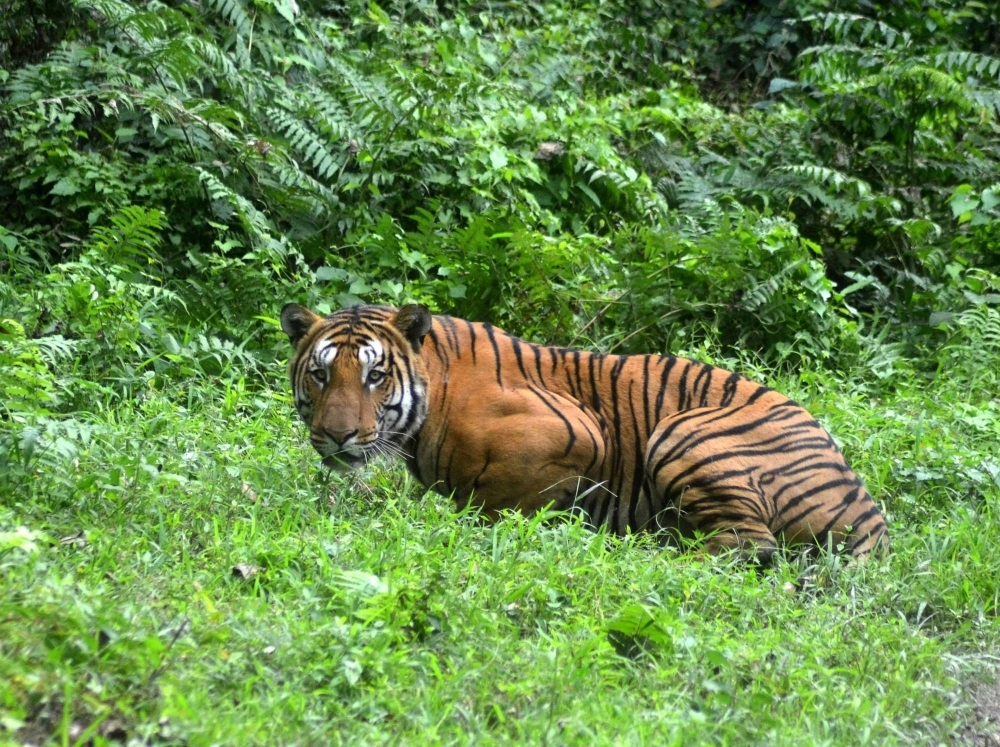Tigers in India are now being photographed in high-altitude mountains rarely seen before, a phenomenon experts attribute to relentless human pressure and a warming climate driving them from traditional hunting grounds.
Researchers from the Wildlife Institute of India (WII) were surprised to discover multiple pictures of tigers in the mountains of Sikkim, an Indian state nestled between Nepal, Bhutan and Tibet, including one captured at an astounding elevation of 3,966 meters. These camera traps were strategically placed in high-altitude regions by Sandeep Tambe, an ecologist and chief warden of Sikkim's forest department, to better understand the impact of climate change on large mammals.
Pooja Pant, a researcher at the Wildlife Institute of India (WII), suggested that one of the major potential factors behind this phenomenon could be the combined impact of climate change and escalating anthropogenic activities.
Tigers have been observed in colder, higher mountains previously, with neighboring Nepal reporting sightings at a record-breaking altitude of 4,000 meters, according to the World Wide Fund For Nature (WWF).
While tigers are typically expected to inhabit warmer forests at lower altitudes as long as there is an adequate prey base, there is now a noticeable trend of them being sighted more frequently at higher elevations.
Although tigers are known to roam across diverse terrains and altitudes, the highest concentration of the big cats in the Corbett Tiger Reserve is in the foothills of the Himalayas, ranging from approximately 385 to 1,100 meters.
In India, Anamitra Anurag Danda, the director of WWF, reported that a tiger was spotted at 3,602 meters by a WWF team in Sikkim in 2019, while another sighting at 3,640 meters in the same state was recorded last year.
Tiger migration
Pranabesh Sanyal, a geologist and prominent tiger expert based in Kolkata, suggests that the observed phenomenon may indicate a range shift among tigers.
"Over the past two decades, temperatures at high altitudes have been warming at a faster rate compared to those below 2,000 meters. This climate change-induced warming is likely facilitating tiger migration," explained Sanyal.
As global temperatures continue to rise due to climate change, scientists have been documenting widespread shifts in the ranges of various species.
Last month, the U.N.'s World Meteorological Organization announced that the 2023 annual average global temperature had soared to 1.45 degrees Celsius above pre-industrial levels (1850-1900), marking it as the warmest year on record.
This alarming rise has prompted scientists to reiterate that any increase surpassing 1.5 degrees Celsius poses the risk of ecosystem collapse and could trigger irreversible shifts in the climate system.
Qamar Qureshi, chairman of the Wildlife Institute of India's (WII) Tiger Cell and a conservation biologist, highlighted that tigers typically favor lower-altitude forested valleys. He expressed concern over the recent trend of tigers venturing into mountainous terrain, interpreting it as a sign of increased pressure on their natural habitats and attributing the pressure to a combination of factors, including the burgeoning human population and the expanding tiger population.
Qureshi also suggested that advancements in technology, such as sophisticated camera traps and the widespread use of camera phones with social media platforms, have contributed to the increased reporting of tiger sightings at higher elevations.
Shrikant Chandola, a former top forest official in Uttarakhand and an expert on tigers, acknowledged that tigers possess the adaptability to cope with cold temperatures. However, he emphasized that human-wildlife conflict is on the rise due to human construction activities resulting in intensified competition for food resources. Chandola noted a decline in the tiger's prey base, which, coupled with increased disturbances, has led to heightened aggression among tigers. He observed that younger tigers are vying for dominance, often displacing older and weaker individuals from their territories.
Small islands in a vast sea
India's tiger population stood at approximately 40,000 during the time of its independence from Britain in 1947. However, this number plummeted to about 3,700 in 2002 and hit an all-time low of 1,411 just four years later. Despite these alarming declines, tiger numbers have steadily rebounded to exceed 3,000 in recent years.
Over the past half-century, India has made significant strides in tiger conservation by more than tripling the number of protected areas. Presently, the country boasts 53 reserves spanning 75,796 square kilometers, an expanse larger than neighboring Sri Lanka.
Despite these conservation efforts, pressures on tiger habitats are intensifying.
"Most tiger reserves and protected areas in India are existing as small islands in a vast sea of ecologically unsustainable land use," India's 2022 Status of Tigers report reads.
"Although some habitat corridors exist that allow tiger movement between them, most of these habitats are not protected areas," it notes, warning those areas "continue to deteriorate further due to unsustainable human use and developmental projects."
Dheeraj Pandey, the field director of the Corbett Tiger Reserve in Uttarakhand state, highlighted ongoing awareness campaigns aimed at minimizing the impact of tigers on the local communities residing around the parks.
This year alone, at least three fatalities and 10 injuries caused by tiger encounters have been reported near the Corbett reserve, fueling growing frustration and anger among locals.
Pandey emphasized the inherent nature of tigers, stating, "We cannot simply instruct the tiger on where it can or cannot go. Instead, measures must be implemented to prevent such encounters."






